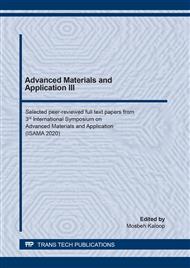[1]
A.R. Sirajunnisa and D. Surendhiran, Algae–A quintessential and positive resource of bioethanol production: A comprehensive review, Renew. Sustain. Energy Rev. 66 (2016) 248–267.
DOI: 10.1016/j.rser.2016.07.024
Google Scholar
[2]
S.A. Jambo, R. Abdulla, S.H. Mohd Azhar, H. Marbawi, J.A. Gansau, and P. Ravindra, A review on third generation bioethanol feedstock, Renew. Sustain. Energy Rev. 65 (2016) 756–769.
DOI: 10.1016/j.rser.2016.07.064
Google Scholar
[3]
C.G. Liu, K. Li, Y. Wen, B.Y. Geng, Q. Liu, and Y.H. Lin, Bioethanol: New opportunities for an ancient product, in: Advances in Bioenergy, Elsevier Inc., 2019, pp.1-34.
DOI: 10.1016/bs.aibe.2018.12.002
Google Scholar
[4]
A.B. Ross, J.M. Jones, M.L. Kubacki, and T. Bridgeman, Classification of macroalgae as fuel and its thermochemical behaviour, Bioresour. Technol. 99 (2008) 6494–6504.
DOI: 10.1016/j.biortech.2007.11.036
Google Scholar
[5]
C.S. Goh and K.T. Lee, A visionary and conceptual macroalgae-based third-generation bioethanol (TGB) biorefinery in Sabah, Malaysia as an underlay for renewable and sustainable development, Renew. Sustain. Energy Rev. 14 (2010) 842–848.
DOI: 10.1016/j.rser.2009.10.001
Google Scholar
[6]
K.H. Kim, I.S. Choi, H.M. Kim, S.G. Wi, and H.J. Bae, Bioethanol production from the nutrient stress-induced microalga Chlorella vulgaris by enzymatic hydrolysis and immobilized yeast fermentation, Bioresour. Technol. 153 (2014) 47–54.
DOI: 10.1016/j.biortech.2013.11.059
Google Scholar
[7]
V.R. Moreira, Y.A.R. Lebron, S.J. Freire, L.V.S. Santos, F. Palladino, and R.S. Jacob, Biosorption of copper ions from aqueous solution using Chlorella pyrenoidosa: Optimization, equilibrium and kinetics studies, Microchem. J. 145 (2019) 119–129.
DOI: 10.1016/j.microc.2018.10.027
Google Scholar
[8]
X. Zhao, X. Tan, L. Yang, J. Liao, and X. Li, Cultivation of Chlorella pyrenoidosa in anaerobic wastewater: the coupled effects of ammonium, temperature and pH conditions on lipids compositions, Bioresour. Technol. 284 (2019) 90-97.
DOI: 10.1016/j.biortech.2019.03.117
Google Scholar
[9]
A. Raheem, P. Prinsen, A.K. Vuppaladadiyam, M. Zhao, and R. Luque, A review on sustainable microalgae based biofuel and bioenergy production: Recent developments, J. Cleaner Prod. 181 (2018) 42–59.
DOI: 10.1016/j.jclepro.2018.01.125
Google Scholar
[10]
C.Y. Chen, X.Q. Zhao, H.W. Yen, S.H. Ho, C.L. Cheng, D.J. Lee, F.W. Bai, and J.S. Chang, Microalgae-based carbohydrates for biofuel production, Biochem. Eng. J. 78 (2013) 1–10.
DOI: 10.1016/j.bej.2013.03.006
Google Scholar
[11]
B.H.H. Goh, H.C. Ong, M.Y. Cheah, W.H. Chen, K.L. Yu, and T.M.I. Mahlia, Sustainability of direct biodiesel synthesis from microalgae biomass: A critical review, Renew. Sustain. Energy Rev. 107(C) (2019) 59–74.
DOI: 10.1016/j.rser.2019.02.012
Google Scholar
[12]
T. Viswanathan, S. Mani, K.C. Das, S. Chinnasamy, A. Bhatnagar, R.K. Singh, and M. Singh, Effect of Cell Rupturing Methods on The Drying Characteristics an Lipid Compositions of Microalgae, Bioresour. Technol. 126 (2012) 131-136.
DOI: 10.1016/j.biortech.2012.08.122
Google Scholar
[13]
T. Simioni, M.B. Quadri, and R.B. Derner, Drying of Scenedesmus obliquus: Experimental and modeling study, Algal Res. 39 (2019) 101428.
DOI: 10.1016/j.algal.2019.101428
Google Scholar
[14]
H. Hosseinizand, S. Sokhansanj, and C.J. Lim, Studying the drying mechanism of microalgae Chlorella vulgaris and the optimum drying temperature to preserve quality characteristics, Drying Technol. 36 (2018) 1049–1060.
DOI: 10.1080/07373937.2017.1369986
Google Scholar
[15]
A.R.C. Villagracia, A.P. Mayol, A.T. Ubando, J.B.M.M. Biona, N.B. Arboleda Jr., M.Y. David, R.B. Tumlos, H. Lee Jr., O.H. Lin, R.A. Espiritu, A.B. Culaba, and H. Kasai, Microwave drying characteristics of microalgae (Chlorella vulgaris) for biofuel production, Clean Technol. Environ. Policy 18 (2016) 2441–2451.
DOI: 10.1007/s10098-016-1169-0
Google Scholar
[16]
S.K., Bagchi, P.S. Rao, and N. Mallick, Development of an oven drying protocol to improve biodiesel production for an indigenous chlorophycean microalga Scenedesmus sp, Bioresour. Technol. 180 (2015) 207-213.
DOI: 10.1016/j.biortech.2014.12.092
Google Scholar
[17]
A.P. Biz, L. Cardozo-Filho, and E.F. Zanoelo, Drying dynamics of microalgae (Chlorella pyrenoidosa) dispersion droplets, Chem. Eng. Proc. Intensification 138 (2019) 41–48.
DOI: 10.1016/j.cep.2019.03.007
Google Scholar
[18]
D. Fithriani, L. Assadad, and A. Siregar, Karakteristik dan Model Matematika Kurva Pengeringan Rumput Laut Eucheuma cottonii Characteristics and Mathematical Model of Drying Curve of Eucheuma cottonii Seaweed, JPB Kelautan dan Perikanan 11 (2016) 159–170.
DOI: 10.15578/jpbkp.v11i2.290
Google Scholar
[19]
Karaaslan, Sevil, O. Uysal, F.O. Uysal, K. Ekinci, and B.S. Kumbul, Mathematical Modelling of Drying of Chlorella sp., Neochloris conjuncta and Botrococcus braunii at Different Drying Conditions, European J. Suistain. Dev. 5 (2016) 421-430.
DOI: 10.14207/ejsd.2016.v5n4p421
Google Scholar
[20]
A.F.R. Silva, H. Abreu, A.M.S. Silva, and S.M. Cardoso, Effect of Oven-Drying on the Recovery of Valuable Compounds from Ulva rigida, Gracilaria sp. and Fucus vesiculosus, Mar. Drugs 17 (2019) 1-17.
DOI: 10.3390/md17020090
Google Scholar
[21]
H. Hosseinizand, S. Sokhansanj, and C.J. Lim, Studying the drying mechanism of microalgae Chlorella vulgaris and the optimum drying temperature to preserve quality characteristics, Drying Technol. 3937 (2017).
DOI: 10.1080/07373937.2017.1369986
Google Scholar
[22]
B Ş. Sert, B. İnan, and D. Özçimen, Effect of Chemical Pre-treatments on Bioethanol Production from Chlorella minutissima, Acta Chim. Slov 65 (2018) 160–165.
DOI: 10.17344/acsi.2017.3728
Google Scholar


